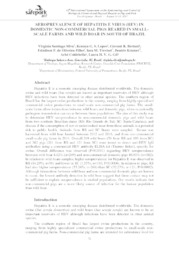Seroprevalence of hepatitis e virus (HEV) in domestic non-commercial pigs reared in small-scale farms and wild boar in south of Brazil.
Seroprevalence of hepatitis e virus (HEV) in domestic non-commercial pigs reared in small-scale farms and wild boar in south of Brazil.
Autoria: SILVA, V. S.; LOPES, K. G. S.; BERTANI, G. R.; OLIVEIRA FILHO, E. F. de; TREVISOL, I. M.; KRAMER, B.; COLDEBELLA, A.; GIL, L. H. V. G.
Resumo: Abstract Hepatitis E is a zoonotic emerging disease distributed worldwide. The domestic swine and wild boars (Sus scrofa) are known as important reservoirs of HEV although HEV infections have been detected in other animal species. The southern region of Brazil has the largest swine productions in the country, ranging from highly-specialized commercial swine productions to small-scale non-commercial pig farms. The smallscale farms allow interactions between wild boars and domestic pigs, when occasionally pathogens transmission can occur between these populations. The aim of this study was to determine HEV seroprevalence in non-commercial domestic pigs and wild boars from two southern Brazilian states (RS: Rio Grande do Sul; SC: Santa Catarina), and discuss if the consumption of raw or undercooked meat from these animals is a potential risk to public health. Animals from RS and SC States were sampled. Serum was harvested from wild boar hunted between 2012 and 2016, and from non-commercial small-scale pig farms in 2014. Overall 249 wild boars (56 from RS and 193 from SC) and 382 pigs (261 from RS and 121 from SC) were tested to detect anti-HEV IgG antibodies using a commercial HEV antibody ELISA kit (Thermo fisher), specific for swine. Overall difference was observed (P<0.0001) regarding HEV seroprevalence between wild boar 4.42% (n=249) and non-commercial domestic pigs 46.60% (n=382). In relation to wild boars samples, higher seroprevalence for Hepatitis E was observed in RS (14.29%; n=56) and lower in SC (1.55%; n=193; P<0.0004). In relation to pigs, RS had also higher seroprevalence (53.26%; n=261) than SC (32.23%; n=121; P<0.0002). Although interactions between wild boar and non-commercial domestic pigs are known to occur, the lowest antibody detection in wild boar suggest that these contact may not be sufficient to explain seroprevalence in studied populations. Our results indicate that non-commercial pigs are a more likely source of infection for the human population than wild boar.
Ano de publicação: 2017
Tipo de publicação: Artigo em anais e proceedings
Unidade: Embrapa Suínos e Aves
Palavras-chave: Encefalomielite, HEV, Javali, Porcine hemagglutinating encephalomyelitis virus, Safe pork, Sanidade animal, Segurança alimentar, Suíno
Observações
1 - Por padrão são exibidas publicações dos últimos 20 anos. Para encontrar publicações mais antigas, configure o filtro ano de publicação, colocando o ano a partir do qual você deseja encontrar publicações. O filtro está na coluna da esquerda na busca acima.
2 - Para ler algumas publicações da Embrapa (apenas as que estão em formato ePub), é necessário ter, no celular ou computador, um desses softwares gratuitos. Sistemas Android: Google Play Livros; IOS: iBooks; Windows e Linux: software Calibre.
Acesse outras publicações
Acesse a Base de Dados da Pesquisa Agropecuária (BDPA) para consultar o acervo completo das bibliotecas da Embrapa.

